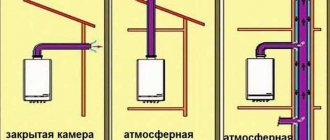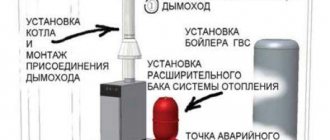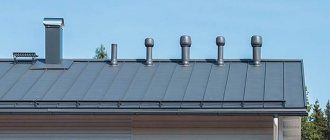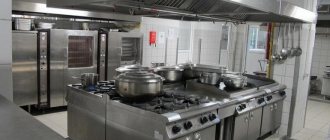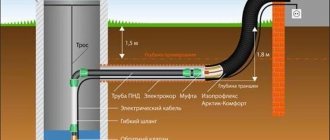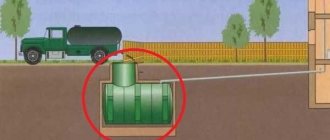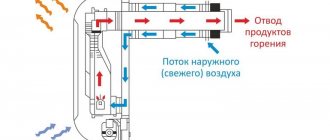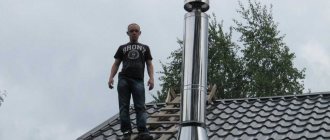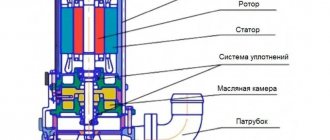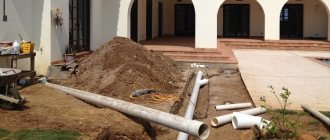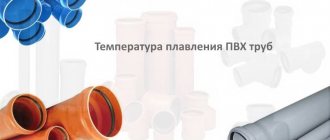Types of brick pipes
There are three types of brick chimney structures, which differ from each other in location.
- Root pipes, they are also attached chimneys. They are built separately from the stove, that is, they are erected next to the heating element, connecting the latter with a chimney outlet (pipe). Typically, such chimney pipes are installed where it is necessary to connect several stoves or fireplaces.
- Mounted option . This is the most common type of chimney. From the name it becomes clear that the structure is installed on top of the stove, as if placed on it.
- Wall design . It is built along the outer wall, that is, the structure is located outside the house, and not inside, like the two previous options. In this case, the wall pipe can be either a mounted or a root pipe. This is the simplest option in terms of building a chimney, but it is more expensive, as it requires a large amount of thermal insulation work.
Wall chimney design Source reddit.com
Calculation of main pipe parameters
All calculations for the chimney must be performed at the design stage of the stove. The project must be carried out by a qualified engineer or craftsman who is well versed in all the nuances of the furnace business. It is impossible to plan the dimensions of the pipe in isolation from the dimensions of the firebox and heat exchanger. Everything is interconnected and must correspond to one goal - the coordinated operation of the furnace equipment.
If, when building a fireplace, the “body” of the stove is missing, and the firebox is directly connected to the chimney, then the Russian stove additionally has heating ducts in the walls, and it is impossible not to make allowances for this. The presence of passages changes the draft and lengthens the path of the flue gases several times. Accordingly, the chimney must create greater vacuum so that the movement of gases is accelerated and soot does not settle inside the passage. A separate topic could be the calculation of the parameters of the chimney in a sauna stove. It is important here that the draft is not excessive, and that the burning fuel has time to transfer heat inside the steam room.
The stove maker’s task includes taking into account not only internal, but also external factors - the location of the pipe in relation to the roof, the characteristics of the local climate, and even the influence of the landscape.
The chimney draft can be affected by tall buildings and trees located nearby, as well as by incorrect choice of chimney height
For gas heating systems, due to their increased fire hazard, the calculation of the chimney parameters is carried out by specialists who develop the boiler. The dimensions are indicated in the technical data sheet and are mandatory.
In private construction, where the combustion is carried out mainly with solid fuel (wood, coal, peat or fuel briquettes), you can adhere to the following rules that will ensure the correct operation of any stove:
- the internal cross-sectional area of a rectangular chimney in closed-type furnaces should not exceed the cross-sectional area of the blower;
- the internal cross-sectional area of the pipe in open-type stoves and fireplaces is calculated in a ratio of 1:10 in relation to the firebox.
It is believed that if the chimney structure has a rectangular shape, the ratio of the short side to the long side should be equal to 1:2. In this case, the minimum permissible cross-sectional size of the channel is 14 x 14 cm.
The size of the brick chimney channel wall should not be less than 14 cm
An important factor is the height of the pipe. Correct calculation allows:
- optimize the operation of the chimney and achieve better efficiency indicators for heat transfer;
- ensure safe operation of the heating device, eliminate the leakage of harmful gases due to weak draft;
- ensure fire safety - if the draft is excessive, sparks and flames may fly out of the pipe.
In general, the height is determined in accordance with SNiP 2.04.05–91:
- the minimum distance from the grate to the top point of the chimney (excluding the protective umbrella) is 5 m;
- the optimal distance is 6 m.
Such parameters ensure stable draft, i.e. the design of the chimney allows you to create a pressure drop sufficient to operate the stove at any time of the year. But in each particular case it is also necessary to take into account:
- The height of the chimney head in relation to the roof ridge. It should be located:
- 0.5 m above the ridge if the chimney is within 1.5 m;
at the level of the ridge, if the chimney is removed at a distance of 1.5 to 3 m;
- not lower than a conventional line drawn from the highest point of the roof at an angle of 10° to the horizontal, in other cases.
- Roof structure, slab thickness, roof slope angle. The length of the riser and the height of the otter depend on this.
- Roof type - single-pitch, gable, flat. There are specific standards for flat roofs: in the absence of parapets, the length of the chimney above the roof plane should be 1.2 m.
- The presence of other devices on the outside of a flat roof, such as ventilation shafts, parapets or protective curbs. With parapets and curbs, the required height increases to 2.2 m. The chimney is located no closer than 5 m from the ventilation hatch.
- Third-party factors - trees located near the house, tall buildings, cliffs, steep river banks. The presence of such factors can create a so-called wind pressure zone, which affects the traction force and interferes with the normal operation of the chimney. The solution to this problem, as a rule, is to increase the height of the pipe.
If there are tall buildings or trees near the house, the chimney must be lengthened, taking into account their top instead of the height of the ridge
The optimal height of the pipe head depends on its location relative to the roof ridge
There is such an unpleasant phenomenon as backdraft. This term refers to the movement of smoke in the chimney in the opposite direction - from the chimney duct into the room. There may be several reasons for this, but the main one is the incorrect position of the chimney. As a rule - underestimated.
An error in choosing the height of the chimney often leads to backdraft
Excess draft can always be eliminated by adjusting the air flow in the ash pan and smoke valves. Insufficient traction is exacerbated in several ways:
- Pipe extension.
- Cleaning the inner surface of the chimney duct.
- Installing a deflector.
The deflector not only increases draft, but also protects the chimney channel from moisture, debris and birds and bats settling in it.
According to experts, by installing a deflector on a chimney you can increase draft by 15–20%
Video: how to calculate the height of the chimney
You will learn about which pipe is best to choose for a chimney, as well as the advantages and disadvantages of materials in our material:.
Chimney design
In the article we will talk about the attachment model, as the most frequently used in the Russian region. The chimney pipe includes (from the bottom of the stove up):
- Kiln neck . Essentially, it is a pipe made of rectangular brick. The neck area is selected according to the furnace power. The greater the power, the larger the cross-section. A steel damper is installed in the neck, with the help of which the cross-section of the chimney is adjusted. With its help, the air supply is regulated.
- Fluff . This is an extended brickwork, which is erected in the overlap area between the rooms and the attic. Its purpose is to protect the ceiling from high temperatures. In fact, a fluff is still the same pipe, only its walls are thicker.
Chimney fluff Source iobogrev.ru
- Boner . This is the longest part of the chimney that runs through the attic space. Its cross section is the same as that of the furnace neck.
- Otter . Same design as fluff. The purpose is to protect the roof structure from high temperatures emanating from the pipe, plus strengthen the chimney to withstand wind loads.
- The neck of the chimney on the roof is made of brick. This is the part visible from the outside, rising above the roof of the house.
- Header . Its purpose is to protect the pipe neck from leaks that usually occur on vertical surfaces during precipitation. That is, the outer diameter of the head is larger than the diameter of the pipe neck.
- Cap . This element of the chimney structure is usually made of galvanized steel sheet. The purpose is to protect the chimney shaft from precipitation getting inside.
Section of a brick chimney above the roof: pipe neck, head and cap Source pinterest.com
See also: Catalog of companies that specialize in roof design and repair services.
Frequent errors and problems during installation
The main mistakes made when laying a chimney yourself.
- Choosing low-quality bricks;
- The seams are too thick;
- Incorrect composition of the solution;
- Incorrect calculation of the height of the chimney;
- Failure to maintain uniformity when laying the channel;
- Failure to comply with fire safety requirements listed above.
Due to errors in installation, turbulence, loss of channel tightness, and poor traction occur. All this leads to a deterioration in the performance properties of the chimney.
Maintenance and cleaning
During operation, soot deposits form on the pipe walls, which must be removed. Professionals recommend cleaning the chimney at least 2 times a year - at the beginning and at the end of the heating season.
There are several cleaning methods:
- Traditional methods
Periodic burning of aspen wood and potato peelings helps to blow away all the soot from the walls of the chimney;
- Chemical method
A special chimney-sweeping log is impregnated with chemical compounds that interact with deposits in the pipe and contribute to their destruction;
- Mechanical cleaning
The most effective method. For mechanical cleaning, you can invite a professional with special equipment, or you can try cleaning it yourself using a brush. Cleaning occurs not only from the roof, but also from below, through the cleaning doors.
Expert advice
Sometimes starting a fire can be difficult. One of the reasons is the presence of condensate, which impairs the movement of gases.
If the chimney is not insulated, heat transfer from hot gases to the environment is observed. When there is a significant difference in temperature inside and outside the chimney, a “dew point” occurs. At this point, the condensate vapor is converted to liquid. This liquid destroys the chimney.
Therefore, it is recommended to insulate the chimney pipe. In this case, all combustion products come out only in a gaseous state.
How to insulate
The easiest way to insulate the outside of brickwork is plaster finishing. To do this, a special mesh is put on the pipe, onto which several layers of plaster are applied. Practice shows that the lifespan of a smoke exhaust protected in this way increases by 2-3 times.
In addition, materials with a low heat transfer coefficient are used for insulation - mineral wool, glass wool, basalt fiber.
In recent years, polystyrene concrete has become popular for insulation. It can be used to make a protective casing for a chimney of any shape.
Some would-be craftsmen line the chimney with insulation without installing a metal casing, and cover the entire structure with foil on top. Such a system is fundamentally wrong and will do more harm than good.
General requirements for chimney pipes
Regardless of the type of chimney, there are three strict rules that must be followed when building a chimney:
- Accurate selection of the height of the brick structure.
- What kind of brick should the chimney over the roof be made of?
- masonry mortar to use for this ?
As for the height, this parameter is calculated taking into account the angle of inclination of the roof structure. So that you understand what we are talking about, look at the photo below, which shows the relationship between the size of the roof and the height of the chimney.
The relationship between the height of the chimney pipe and the roof parameters Source kaminbrick.ru
It is important to understand that the correctly selected height of the pipe structure is, first of all, good draft inside the pipe, which guarantees proper operation of the stove. Secondly, it is compliance with fire safety standards and requirements. This mainly applies to roofs made from flammable materials. Because the turbulence of air masses can cause eggs to fall on the roofing. And this often causes a fire.
Now let's move on to the bricks. Everything is simple here.
- Parts of the pipe exposed to high thermal loads must be assembled from fireclay (refractory) bricks. This mainly applies to the neck of the furnace.
- The remaining parts can be raised from M200 red brick. This material easily tolerates temperatures up to +800C.
The neck of the furnace is lined with fireclay bricks Source lv.aviarydecor.com
What is the difference between the chimney of a gas boiler and a solid fuel boiler?
A gas boiler
Solid fuel boiler
The main task of any chimney is to remove exhaust gases and maintain the draft necessary for air to enter the combustion zone. When both solid fuel and gas burn, carbon dioxide (carbon dioxide) and water vapor are formed in the bulk.
The smoke also contains other impurities (most often harmful) and particles of unburned fuel (soot). But still, special requirements are imposed on chimneys for gas boilers. Let's tell you why.
Safety
Not the worst consequences of a gas boiler explosion due to a chimney.
With a properly adjusted burner, the presence of impurities in the flue gases is minimal. Therefore, the chimneys of a gas boiler are less polluted. But they need to be inspected and cleaned much more often. The fact is that the lack of traction can lead to more severe consequences than with solid fuel boilers.
- Incomplete combustion of fuel leads to the formation of poisonous carbon monoxide. A change in burner settings can also occur due to a decrease in draft. Moreover, unlike a solid fuel boiler, this is difficult to notice. The smoke from the gas is clean and unnoticeable; there may be no burning smell in the room.
- Extinguishing the flame can cause gas accumulation in the room and a subsequent explosion (especially if the safety automatics are faulty or disabled). In many boiler models, the absence of flame can only be checked by indicators; the burner itself is often hidden inside the casing.
Therefore, a chimney for a brick gas boiler must have a design that allows for easy inspection and cleaning. There are also special fire safety requirements for the chimneys of gas boilers. The reason is the same - possible accumulation of gas in the premises.
If a brick chimney for a solid fuel boiler is overheated or sparks penetrate through its defects, the furnishings and building structures in an ordinary room may catch fire, but in the presence of gas, the word “may” does not apply. The likelihood of a fire or explosion increases tenfold.
Special working conditions
Another feature of gas boiler chimneys is the possible formation of condensation on surfaces. When conventional fuel burns, less water vapor is formed, and the temperature at the chimney exit is higher than the dew point. For gas equipment, this condition is not always met.
Icicles on the pipe cut due to condensation
Note that some boiler models require a special reduction in the temperature of the exhaust gases (for example, Vitocond). In this way, the use of heat from fuel combustion is increased.
If you see in an advertisement that the efficiency is more than 100% (which contradicts the laws of thermodynamics), then most likely you are dealing with just such a design. The unrealistic figure is due to the use of an efficiency calculation method that does not take into account the reduced temperature of the flue gases.
Condensation causes moisture to accumulate in the materials from which chimneys are made, which leads to their destruction. Parts of the pipe located outside deteriorate even faster in winter - water freezes and ice causes cracks.
The second unpleasant factor associated with condensation is the destruction of materials from chemicals. Carbon dioxide dissolves in water, forming a weak but still acid. With an increased sulfur content in the burned gas, a more aggressive environment is formed (everyone knows about the effect of sulfuric acid).
Sulfuric acid is contained in the condensate
Therefore, chimneys for gas boilers must have devices for condensate removal. Materials for pipe construction must be resistant not only to elevated temperatures, but also to moisture and aggressive substances.
Brick can only work in such conditions for a short time, so often the chimney of a gas boiler has a steel or ceramic liner inside. An acceptable option is brick plastered with special mixtures.
Brick chimney for gas boiler with internal liners
Now let’s take a closer look at what needs to be taken into account when building a brick chimney for a gas boiler so that it is safe and durable, and there are no questions when accepted by the relevant services.
Chimney section
The chimney of a gas boiler must ensure complete removal of combustion products. Therefore, its cross-sectional area is specified in the boiler instructions. If there is no such information, then you should take based on the norm no more than 5.2 square centimeters per kilowatt of power. More is possible, less is not possible.
Advice. You can also orient it according to the boiler outlet area; it cannot be less than permissible.
The geometric shape is chosen such that the area of contact of the structure with gases is minimal. Ideally, a circle, but for technological reasons, a rectangle is more often chosen for bricks. I also often use the option when a rectangular brick box is built around a round sleeve.
This reduction in the area of contact with gases is necessary for two reasons:
- The heat transfer from smoke to the structure is reduced. The pipe heats up less, therefore, it is safer in terms of fire. Also, the higher the temperature of the flue gases, the less condensate is formed in them.
- Improves traction . Although the flow resistance due to the formation of vortices near the walls is minimal, this small amount is important.
In addition, there are two more restrictions on the pipe cross-section:
- Expansion and contraction of the pipe along its entire length is not allowed;
- If the pipe is rectangular, then the aspect ratio is no more than one to two.
Wall thickness
As mentioned above, the design of a brick chimney for a gas boiler should be such that heat transfer through the walls is minimal. Ceramics itself has good thermal insulation properties; as practice shows (even without resorting to calculations), laying one and a half to two bricks is sufficient. But keep in mind that when passing through combustible structures, the thickness should increase. More on this below.
Chimney shape
Shape of the chimneys of a gas boiler
In order for the construction of a brick chimney for a gas boiler to create minimal resistance to the flow of gases, it must have a minimum number of bends. For boilers without forced air pressurization devices or smoke exhausters (excluding the channel through which the boiler is connected to the chimney), the pipe must generally be strictly vertical.
We list all the requirements for the shape of the chimney:
- The number of bends is no more than three.
- Deviation from the axis is not allowed by more than one meter.
- The slope should not be more than 30 degrees.
- Downward slopes are not allowed.
- The diameter of the roundings must be larger than the diameter of the pipe.
All these requirements are clear - the flow of gases must move exclusively upward, the construction of a chimney for a brick gas boiler does not allow areas with a decrease.
Chimney height
The height of the chimney above the ridge.
The higher it is, the better the draft of the chimney. Of course, for a private house it is not worth building a version of a factory chimney, especially if the boiler is pressurized or has a smoke exhauster. The rules require that the pipe be 1 meter higher than the roof.
If the roof is pitched, then here are instructions for selecting the minimum height:
- if the pipe is closer than one and a half meters to the ridge - then 0.5 meters;
- if the pipe is further, but no more than three meters, it can be made flush with the ridge;
- at a greater distance, it is allowed to lower the pipe to such a height that its top point makes an angle to the horizontal with the ridge of no more than 10 degrees.
Connecting other heating devices to the gas boiler pipe
Several chimneys under one lining
Brick chimneys for solid fuel boilers allow the simultaneous connection of several heating devices (boiler, fireplace, stove). For gas boilers, this approach is unacceptable.
Even if the chimney cross-section is sufficient, this is prohibited due to the fact that gas can penetrate into other rooms through the chimney channel. If you don’t want to decorate the roof with several pipes, then simply block them in one common cladding.
Surface of internal walls
Such a surface of the internal walls of the boiler is unacceptable.
In order to prevent the adhesion of soot and again improve the conditions for removing smoke, the surface inside the chimney should be as smooth as possible. Therefore, the composition for plastering pipes without liners should not contain large aggregates. The mixture freshly laid on the surface should be rubbed as efficiently as possible.
Technology for constructing a brick chimney
So, the laying of a brick pipe on the roof must be provided for at the stage of building a house. This will make it easier to carry out the entire construction process. That is, there will be no need to make holes in the ceilings and roof structure. It should be added that the mounted version rises along with the stove. There is no other option here. The attached (root) or wall-mounted one can be erected after the furnace has been installed, since both structures are free-standing.
In fact, the design of a brick chimney is simple. But the process of its construction itself is complicated, because each row of bricks being laid requires the craftsman to place them exactly where they should be laid, aligning each row horizontally. At the same time, it is very important to achieve the evenness of the vertical planes that form the inner pipe. It is this that is the most important element of the entire structure, because the draft and operating efficiency of the heating equipment depend on it.
There are several schemes for laying bricks in a chimney structure. But the simplest one is shown in the photo below. Please note that the masonry is carried out in half a brick, and this is enough to talk about the effectiveness of the assembled structure. What is important here is not the laying method itself or the installation scheme of the bricks, it is important to observe the cross-sectional area of the inner strip.
Laying a half-brick chimney Source soverthrit.mihanblog.com
That is, it turns out that the trunk of the chimney structure is erected above the stove almost equally along the entire height of the structure. The only deviation is fluff and otter, where the bricks are laid in a more extended position. We invite you to watch the video.
Installation features
The simplest option for installation is a mounted chimney. How to lay out a pipe with your own hands? Let's consider the method of laying a classic chimney for a sauna stove:
- We calculate the parameters of the chimney using one of the methods given above;
The standard channel cross-section for a sauna stove is 250x120mm, which is exactly the size of a red brick; in addition, you will need half bricks. They can be bought or cut off;
The mortar is laid with a thickness of no more than 1 cm, preferably a clay composition with the addition of cement;
- We prepare everything necessary - bricks, mortar, tools;
- Take measurements for fluff, gate and otter;
- Laying should begin from the stove, checking each row with a building level. Periodically clean the channel of excess solution;
- Advice - after laying the first two or three rows of bricks, fasten ropes at the corners of the future chimney and stretch them to the ceiling (strictly vertically). They are used to control the position of the chimney;
- It is necessary to secure the frame at the installation site of the gate valve;
- Continue laying the brick until it is fluffy. Before installing the fluff, it is necessary to count the number of its rows. In one row, the diameter of the channel increases by ¼ of the width of the brick. The brick terminals must be tightly attached to the floor beams, there should be no gaps between them, otherwise the chimney will wobble
- The fluff should be placed according to the diagram (see above, Fig. 1). It can be changed based on your size;
- After laying the fluff, we continue laying the chimney;
- We begin to lay the otter from the underside of the roof; the increase in the cross-section of the chimney when laying the otter should take into account the slope of the roof slope, gradually;
- Advice - to increase stability, metal plates should be embedded in the otter;
- If necessary, trim the ends of the bricks;
- Head device. To do this, we increase the outer perimeter by a quarter of a brick;
- Finish row. We install a bird net in it. We fasten the protective cap on top with dowels.
Advantages and disadvantages of brick chimneys
Let's start with the advantages of brick chimneys:
- The main one is long service life . There are many examples in which brick chimneys have served for more than 1000 years.
- The thermal conductivity and heat capacity of the brick allows the chimney to act as an additional heating element. This is true in houses with several floors, especially for the attic.
- The aesthetic qualities of brick should also be placed in the category of “pluses” of this type of construction. This building material will fit perfectly into any home interior design.
Brick chimney in the interior of a private house Source orchardo.ru
Materials and sizing calculations
It is recommended to make the chimney for the boiler cylindrical in shape, since the corners create obstacles for the escape of smoke - soot accumulates in them. The size depends on the power of the solid fuel boiler - per 1 kW - 8 cm² in cross section. The pipe is made 5 meters high, and the horizontal cut is 1 meter.
When building a structure, you will need brick (burnt) and mortar. For such a mixture, it is made of cement, sand, clay and water. No debris should get into the mixture; the absence of lumps is important. Tools you will need:
- level;
- roulette;
- hammer;
- trowel;
- fishing line
Where to place it?
It is allowed to make a chimney for the boiler inside the house or outside. Both options have their advantages and disadvantages, shown in the table:
| Location | pros | Minuses |
| In the house | Part of the structure in the attic and roof is insulated | Fires and carbon monoxide leaks are more common |
| Outside the building | Safer to use | The entire pipe requires thermal insulation |
| Repair work is easy to do |
Passage through floors and roofs
Here, the installation of a chimney for brick gas boilers is subject to the same requirements as for conventional chimneys.
The order of cutting the chimney
- When passing through a ceiling made of combustible materials, cutting (thickening of the external size of the pipe) must be ensured at a distance of at least 250 mm. It is possible to reduce this size to 150 mm if you use thermal protection made of asbestos and steel.
- When passing through fireproof ceilings, a gap of at least 100 mm must be provided.
- At the chimney outlet through a roof made of sheet materials, at the place where the pipe passes, an apron is made of tin or similar material, spaced from its perimeter by at least 100 mm for fireproof roofing coverings (asbestos fiber sheets, tiles, etc.) and 250 mm for flammable (ondulin, soft coatings based on bitumen). Also, the distance to the wooden elements of the rafter structure and sheathing must be at least 25 cm.
It is advisable to install a deflector at the head of the chimney. It will provide increased traction and protect the pipe channel from moisture and foreign objects.
Advice. A deflector or visor is additionally needed because for some reason birds are not only accustomed to resting on the heads of pipes, but also to clog them with their droppings. Often the reason for the decrease in pipe draft is a tired, poisoned crow or dove that has fallen inside and naturally is unable to get out.
Even a homemade visor saves you from blockage
